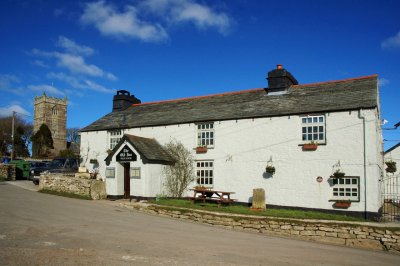


Ancient village high on the moor
Web: www.stbreward.net
An old village situated on the western side of Bodmin Moor approximately six miles north of Bodmin and high above the River Camel. It is accessed from lanes leaving the east side of the B3266 south of Camelford. The population of the village was 886 at the 2011 census.
The parish church is situated at the northern end of the village and is dedicated to St. Branwalader (or Brueredus). It is a substantial building of the Norman period to which a south aisle and western tower were added in the 15th century. Situated further towards the bottom of the village, the War Memorial Hall is used for monthly events such as the gardening club.
The moorland area of the parish is notable for prehistoric remains, including the earthwork known as King Arthur's Hall. For many centuries St. Breward's main industry was the mining of granite which has been used in Cornwall and exported to many other places. The most important quarry is De Lank which produces granite of very high quality. Moorland Granite has been used for centuries to build local houses and churches and stone from St. Breward quarries was used for important and famous landmarks including the Eddystone Lighthouse in 1882, the Beachy Head Lighthouse in 1900 and Tower Bridge in 1890 and London Bridge in 1991. More recently china clay has also been quarried there. There is another important china clay works at Stannon. Also within the parish lie two of Cornwall's best known landmarks: Roughtor and Brown Willy.
In the 17th century St. Breward was two separate villages, Churchtown (higher) and St. Breward (lower). More houses were built and slowly the villages merged into one. There are several main parts to the village: Churchtown, Rylands, Row, Limehead, Wenford, Penvorder, Higher Penquite and Lower Penquite.
The village has a footpath which takes you in a loop past the holy well, the aviaries, and the church. It has a shop, a snooker club, the village hall, a football club (Brake Parc FC), two playgrounds (one at Rylands, and the other in Penvorder), a Methodist chapel and Sunday school, an Anglican church, a pub (The Old Inn), and a war memorial hall.
A mile south of the village is Wenfordbridge which is the northern terminus of The Camel Trail.
Trevor Colman (1941–2022) former UKIP MEP was born and raised in St. Breward.
George Martin (1864–1946) was born at St. Breward and became a priest in the Church of England who gave up his living and went to Southwark, where he became known among the poor as the 'modern St. Anthony'.
Brian Hanscomb (born 1944) artist and engraver also lives in the village.
St. Breward Feast Day - February.
St. Breward Carnival - Early July.
Blisland Camelford Bodmin Moor St. Tudy The Copper Trail Wenford Bridge Pottery